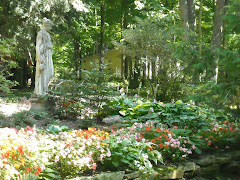Like most industry professionals, I have been contemplating how we are going to adjust to the pressures of today's fuel prices. The cost of everything is rising. From the pump to the grocery checkout aisle, everyone is paying the price. Historically, times of crisis and challenge give birth to opportunity and innovation. The way we approach everyday things like landscaping and gardening will gradually change too. I have long felt that the sprawling "Suburban Lawn" concept of the 50's and 60's is an outdated notion. Now before I get arouse the ire of the John Deere Nation, let me explain… There are two things to consider here; Time and resources. Our lives are much more complex today than in the Ozzie and Harriet days of old. The pace is faster, and often times the candle burns at both ends and the middle. Considering your lifestyle, how much time are you willing to spend maintaining your landscape? What is the intended use of your turf area? (Recreation, pets, etc.). Larger lawns require more time, equipment, water and fuel. A solution would be to downsize the lawn area. Create a circular or oval lawn that serves as a lush, green center piece for your landscape and adds further interest with the surrounding planting beds. This is also a great time to address any cosmetic enhancements to your home. Take a look at the sight lines from inside your home. Things like window to window exposure, unsightly storage areas and lighting can all be masked by the proper placement of planting beds and trees. Next, examine the exterior view of your home. Again, the proper placement of trees and planting beds can enhance the architectural features or soften the less desirable views. Once you have an idea of where to plant, now we can begin to consider what to plant. The next question I would pose is… Irrigation or Xericape? With over 32 million acres, our beloved lawns are the largest irrigated crop in the United States. Over one third of residential water usage is consumed in the effort to maintain them. Xeriscape – which is a word derived from the combination of the Greek word xeros which means dry, and landscaping, Wikipedia defines Xeriscaping as "Landscaping in ways that do not require supplemental irrigation". This practice is gaining popularity in the southern regions and in the arid west, and its principals are beneficial right here in the upper Mid-west. Selecting drought tolerant trees, shrubs and perennials from a rather long list, combined with mass plantings of ground covers and adequate coverage of mulch will provide you relief with your water bill. And a final thought… Throw away your bird feeder and go Native! There is a wonderful variety of native shrubs and perennials that attract songbirds, hummingbirds and butterflies. Providing a beautiful spring blooms, summer berries and Vibrant fall color. With proper planning and a bit of imagination, this is a case where less turns out to be much, much more.
James "Motor" Merritt
Partner and Creative Director of Living Color Landscapes
715-849-9600 – www.livingcolorlandscapes.net
Tuesday, June 24, 2008
Subscribe to:
Post Comments (Atom)






No comments:
Post a Comment